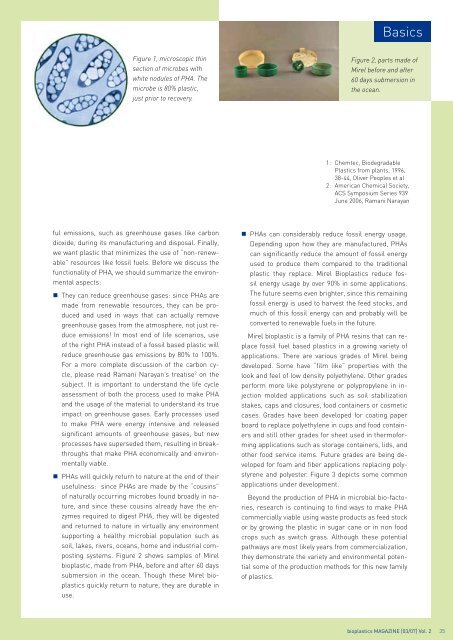bioplasticsMAGAZINE_0703
bioplasticsMAGAZINE_0703
bioplasticsMAGAZINE_0703
Create successful ePaper yourself
Turn your PDF publications into a flip-book with our unique Google optimized e-Paper software.
Basics<br />
Figure 1, microscopic thin<br />
section of microbes with<br />
white nodules of PHA. The<br />
microbe is 80% plastic,<br />
just prior to recovery.<br />
Figure 2, parts made of<br />
Mirel before and after<br />
60 days submersion in<br />
the ocean.<br />
1: Chemtec, Biodegradable<br />
Plastics from plants, 1996,<br />
38-44, Oliver Peoples et al<br />
2: American Chemical Society,<br />
ACS Symposium Series 939<br />
June 2006, Ramani Narayan<br />
ful emissions, such as greenhouse gases like carbon<br />
dioxide, during its manufacturing and disposal. Finally,<br />
we want plastic that minimizes the use of “non-renewable”<br />
resources like fossil fuels. Before we discuss the<br />
functionality of PHA, we should summarize the environmental<br />
aspects:<br />
• They can reduce greenhouse gases: since PHAs are<br />
made from renewable resources, they can be produced<br />
and used in ways that can actually remove<br />
greenhouse gases from the atmosphere, not just reduce<br />
emissions! In most end of life scenarios, use<br />
of the right PHA instead of a fossil based plastic will<br />
reduce greenhouse gas emissions by 80% to 100%.<br />
For a more complete discussion of the carbon cycle,<br />
please read Ramani Narayan’s treatise 2 on the<br />
subject. It is important to understand the life cycle<br />
assessment of both the process used to make PHA<br />
and the usage of the material to understand its true<br />
impact on greenhouse gases. Early processes used<br />
to make PHA were energy intensive and released<br />
significant amounts of greenhouse gases, but new<br />
processes have superseded them, resulting in breakthroughs<br />
that make PHA economically and environmentally<br />
viable.<br />
• PHAs will quickly return to nature at the end of their<br />
usefulness: since PHAs are made by the “cousins”<br />
of naturally occurring microbes found broadly in nature,<br />
and since these cousins already have the enzymes<br />
required to digest PHA, they will be digested<br />
and returned to nature in virtually any environment<br />
supporting a healthy microbial population such as<br />
soil, lakes, rivers, oceans, home and industrial composting<br />
systems. Figure 2 shows samples of Mirel<br />
bioplastic, made from PHA, before and after 60 days<br />
submersion in the ocean. Though these Mirel bioplastics<br />
quickly return to nature, they are durable in<br />
use.<br />
• PHAs can considerably reduce fossil energy usage.<br />
Depending upon how they are manufactured, PHAs<br />
can significantly reduce the amount of fossil energy<br />
used to produce them compared to the traditional<br />
plastic they replace. Mirel Bioplastics reduce fossil<br />
energy usage by over 90% in some applications.<br />
The future seems even brighter, since this remaining<br />
fossil energy is used to harvest the feed stocks, and<br />
much of this fossil energy can and probably will be<br />
converted to renewable fuels in the future.<br />
Mirel bioplastic is a family of PHA resins that can replace<br />
fossil fuel based plastics in a growing variety of<br />
applications. There are various grades of Mirel being<br />
developed. Some have “film like” properties with the<br />
look and feel of low density polyethylene. Other grades<br />
perform more like polystyrene or polypropylene in injection<br />
molded applications such as soil stabilization<br />
stakes, caps and closures, food containers or cosmetic<br />
cases. Grades have been developed for coating paper<br />
board to replace polyethylene in cups and food containers<br />
and still other grades for sheet used in thermoforming<br />
applications such as storage containers, lids, and<br />
other food service items. Future grades are being developed<br />
for foam and fiber applications replacing polystyrene<br />
and polyester. Figure 3 depicts some common<br />
applications under development.<br />
Beyond the production of PHA in microbial bio-factories,<br />
research is continuing to find ways to make PHA<br />
commercially viable using waste products as feed stock<br />
or by growing the plastic in sugar cane or in non food<br />
crops such as switch grass. Although these potential<br />
pathways are most likely years from commercialization,<br />
they demonstrate the variety and environmental potential<br />
some of the production methods for this new family<br />
of plastics.<br />
bioplastics MAGAZINE [03/07] Vol. 2 35


















